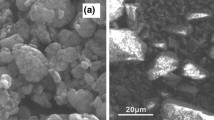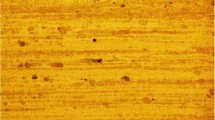Abstract
Fillet welding methodology of molybdenum end plug and Nb1Zr thin tube was explored by presetting niobium filler material with square cross section and inserting titanium foil between the filler material and the end plug. It was found that the incidence angle of laser beam greatly affected the energy density on workpiece surface and the intensity of metal evaporation. The weld quality was poor under thermal conduction welding mode, due to the geometric asymmetry of the joint and the difference of physical properties between Mo and Nb1Zr. Under deep penetration mode, the melting behavior of the filling material was dominated by recoil pressure induced by intense evaporation and fillet joint free of defects was obtained. Analysis of microstructures and performance revealed that various elements were distributed uniformly in the fusion zone (FZ) of the fillet joints, without brittle intermetallic compounds (IMCs). Mixture of Mo and Nb in the FZ presented a significant solid-solution strengthening effect, while the TiO2 and Nb2O5 phases generated during welding were dispersed in the FZs, causing dispersion strengthening and grain boundary strengthening. The larger number of high-angle grain boundaries (HAGBs) in the heat-affected zone (HAZ) was responsible for the softening of HAZ. The average microhardness of FZ was much higher than that of base metal (BM) in both sides, reaching 399.8 HV. The joints were fractured in the HAZ in the Nb1Zr side in the tensile tests, where the tensile strength (395.6 MPa) declined slightly compared with that of the BM (408.2 MPa), showing ductile fractures.


















Similar content being viewed by others
References
L. Ye, Z. Lei, Z. Yuanfeng, and H. Yanpin, Review of Heat Pipe Application in Advanced Nuclear Reactors, Nucl. Power Eng., 2016, 37(6), p 121–124.
C. Wang, L. Zhang, X. Liu, S. Tang, S. Qiu, and G.H. Su, Experimental Study on Startup Performance of High Temperature Potassium Heat Pipe at Different Inclination Angles and Input Powers for Nuclear Reactor Application, Ann. Nucl. Energy, 2020, 136, 107051.
M.L. Hamilton, D.S. Gelles, R.J. Lobsinger, G.D. Johnson, W.F. Brown, M.M. Paxton, R.J. Puigh, C.R. Eiholzer, C. Martinez, and M.A. Blotter, Fabrication Technological Development of the Oxide Dispersion Strengthened Alloy MA957 for Fast Reactor Applications, Pacific Northwest National Lab. (PNNL), Richland, WA (United States), 2000.
M.L. Hamilton, D.S. Gelles, R.J. Lobsinger, M.M. Paxton, and W.F. Brown, Fabrication Technology for ODS Alloy MA957, Pacific Northwest National Lab. (PNNL), Richland, WA (United States), 2000.
S. Ukai, M. Harada, H. Okada, M. Inoue, S. Nomura, S. Shikakura, K. Asabe, T. Nishida, and M. Fujiwara, Alloying Design of Oxide Dispersion Strengthened Ferritic Steel for Long Life FBRs Core Materials, J. Nucl. Mater., 1993, 204, p 65–73.
S.R. Lampman and T.B. Zorc, Chapter on Refractory Metals and Alloys, Metals Handbook, 10th ed., (Metals Park, OH), American Society for Metals (ASM) International, 1990, p 557.
L.B. Lundberg, Critical Evaluation of Molybdenum and Its Alloys for Use in Space Reactor Core Heat Pipes, Los Alamos National Lab. (LANL), Los Alamos, NM (United States), 1981
M.S. El-Genk and J.-M. Tournier, A Review of Refractory Metal Alloys and Mechanically Alloyed-Oxide Dispersion Strengthened Steels for Space Nuclear Power Systems, J. Nucl. Mater., 2005, 340(1), p 93–112.
L.L. Zhang, L.J. Zhang, J. Ning, Y.J. Sun, W.I. Cho, and S.J. Na, On the Laser Gas (N2) Alloying in the Welding of Molybdenum Alloy, J. Mater. Process. Technol., 2021, 296, 117184.
A. Chatterjee, S. Kumar, R. Tewari, and G.K. Dey, Welding of Mo-Based Alloy Using Electron Beam and Laser-GTAW Hybrid Welding Techniques, Metall. Mater. Trans. A, 2016, 47(3), p 1143–1152.
G. Zhang, G. Chen, H. Cao, R. Liu, B. Zhang, and X. Leng, Uncovering the Weakening Mechanism of Electron Beam Welded Joints of La2O3 Dispersion Strengthened Molybdenum Alloy: Experiment and Simulation, Mater. Lett., 2023, 333, 133586.
M. Stütz, R. Buzolin, F. Pixner, C. Poletti, and N. Enzinger, Microstructure Development of Molybdenum during Rotary Friction Welding, Mater Charact, 2019, 151, p 506–518.
X.G. Song, X. Tian, H.Y. Zhao, X.Q. Si, G.H. Han, and J.C. Feng, Interfacial Microstructure and Joining Properties of Titanium–Zirconium–Molybdenum Alloy Joints Brazed Using Ti–28Ni Eutectic Brazing Alloy, Mater. Sci. Eng. A, 2016, 653, p 115–121.
C. Xia, L. Wu, X. Xu, and J. Zou, Phase Constitution and Fracture Analysis of Vacuum Brazed Joint of 50Mo-50Re Refractory Alloys, Vacuum, 2017, 136, p 97–100.
M.X. Xie, Y.X. Li, X.T. Shang, X.W. Wang, and J.Y. Pei, Effect of Heat Input on Porosity Defects in a Fiber Laser Welded Socket-Joint Made of Powder Metallurgy Molybdenum Alloy, Materials, 2019, 12(9), p 1433.
D.P. Kramer, J.R. McDougal, B.A. Booher, J.D. Ruhkamp, E.I. Howell, and J.J. Kwiatkowski, Electron Beam and Nd-YAG Laser Welding of Niobium-1% Zirconium and Molybdenum-44.5% Rhenium Thin Select Material, in Collection of Technical Papers. 35th Intersociety Energy Conversion Engineering Conference and Exhibit (IECEC) (Cat. No.00CH37022), 2000, p 956–961 vol.2.
P. Liu, K. Feng, and G. Zhang, A Novel Study on Laser Lap Welding of Refractory Alloy 50Mo–50Re of Small-Scale Thin Sheet, Vacuum, 2017, 136, p 10–13.
X.-L. Gao, L.-J. Zhang, J. Liu, and J.-X. Zhang, A Comparative Study of Pulsed Nd:YAG Laser Welding and TIG Welding of Thin Ti6Al4V Titanium Alloy Plate, Mater. Sci. Eng. A, 2013, 559, p 14–21.
D.L. Chandramohan, K. Roy, H. Taheri, M. Karpenko, Z. Fang, and J.B.P. Lim, A State of the Art Review of Fillet Welded Joints, Materials, 2022, 15(24), p 8743.
A. Ambroziak, Friction Welding of Molybdenum to Molybdenum and to Other Metals, Int. J. Refract. Met. Hard Mater., 2011, 29(4), p 462–469.
L. Zhang, G. Lu, J. Ning, L. Zhang, J. Long, and G. Zhang, Influence of Beam Offset on Dissimilar Laser Welding of Molybdenum to Titanium, Materials, 2018, 11(10), p 1852.
X.R. Zhou, J. Ning, S.J. Na, and L.J. Zhang, Microstructures and Properties of the Dissimilar Joint of Pure Molybdenum/T2 Copper by Single-Mode Laser Welding, Int. J. Refract. Met. Hard Mater., 2021, 101, 105667.
L.J. Zhang, R.Y. Ma, Y.B. Zhang, Q. Guo, C.H. Wang, J.X. Zhang, and S.J. Na, Investigation on Dissimilar Laser Beam Welding of Molybdenum to Zirconium via Pure Titanium Interlayer, Opt. Laser Technol., 2020, 131, 106327.
L.L. Zhang, L.J. Zhang, J. Long, J. Ning, J.X. Zhang, and S.J. Na, Effects of Titanium on Grain Boundary Strength in Molybdenum Laser Weld Bead and Formation and Strengthening Mechanisms of Brazing Layer, Mater. Des., 2019, 169, 107681.
L.L. Zhang, Y. Zhou, L.J. Zhang, J. Ning, Y.J. Sun, and S.J. Na, Effect of Niobium on the Mechanical Strength of the Laser Beam Welding Joints of Molybdenum, Int. J. Refract. Met. Hard Mater., 2023, 113, 106207.
Acknowledgments
This work was supported by the National Key Research and Development Project of the P. R. China (Grant No. 2022YFB3707602) and the Natural Science Foundation of China (Grant No. 51775416). Thanks to the teachers in the Analysis and Test Center of Xi'an Jiaotong University for their help in the experiment in this paper.
Author information
Authors and Affiliations
Contributions
Jiaxuan Zhao helped in conceptualization, data curation, investigation, writing—original draft, writing—review & editing. Linjie Zhang was involved in validation, investigation, methodology, writing—review & editing. Suck-Joo Na contributed to investigation, methodology, resources. Guang Sun helped in theoretical guidance, methodology, validation.
Corresponding author
Ethics declarations
Competing interests
The authors declare no competing interests.
Additional information
Publisher's Note
Springer Nature remains neutral with regard to jurisdictional claims in published maps and institutional affiliations.
Rights and permissions
Springer Nature or its licensor (e.g. a society or other partner) holds exclusive rights to this article under a publishing agreement with the author(s) or other rightsholder(s); author self-archiving of the accepted manuscript version of this article is solely governed by the terms of such publishing agreement and applicable law.
About this article
Cite this article
Zhao, J., Zhang, L., Na, SJ. et al. Fiber Laser Fillet Welding of Nb1Zr Thin Tube and Molybdenum End Plug in Ultra-high-Temperature Heat Pipe. J. of Materi Eng and Perform (2024). https://doi.org/10.1007/s11665-024-09375-w
Received:
Revised:
Accepted:
Published:
DOI: https://doi.org/10.1007/s11665-024-09375-w




